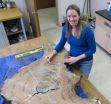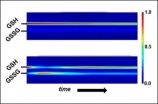(Press-News.org) With the world watching the Sochi Winter Olympics including the biathlon shooting events, now is the time for the International Olympic Committee (IOC) to ban the use of lead shot to prevent wildlife poisoning and health threats to surface and groundwater, says a new paper co-authored this month by a University of Guelph biologist.
Thousands of tons of lead shot discharged every year during training by Olympic shooters pose a threat to birds and mammals and to water resources, says Vernon Thomas, professor emeritus in the Department of Integrative Biology.
His paper "Banning the Use of Lead Shot: Options for the International Olympic Committee" appears in the current issue of the journal Environmental Policy and Law.
He wrote the article proposing IOC policy options with David Anderson, former Canadian minister of the environment and former chair of the governing council of the United Nations Environment Program (UNEP).
They began working together on environmental policy when Anderson joined U of G in 2007 as part-time director of the former Guelph Institute for the Environment.
Thomas said the Winter Olympic biathlon now under way in the Sochi Games is not the problem, as lead shot is recovered and recycled from targets.
In the Summer Games, clay target shooting releases lead shot, but even that amount of lead discharged every four years is minimal, he said.
The real problem stems from athletes training between the Olympic Games. Thomas said each Olympic shooter discharges more than a ton of lead shot each year on and around practice shooting ranges.
"The real concern is the amount of shot released during the four-year interval by the many hopefuls in each country and the Olympic team members of each country who practise assiduously with over 1,000 shots per week.
"This lead shot – many tons – is rarely recovered and poses real toxic risks to wildlife that may ingest it and to groundwater quality."
He said non-toxic substitutes – especially steel shot – have been available for about two decades.
Only lead shot is approved by the International Shooting Sport Federation (ISSF), which regulates Olympic trap and skeet shooting events. The ISSF also oversees qualification of athletes for the Olympic Games for each member nation.
Thomas said ISSF rules on lead shot use contravene an IOC Charter rule meant to ensure that all Olympic events are sustainable and pose no environmental harm.
Lack of attention to the environmental effects of Olympic shooting is also inconsistent with UNEP's efforts globally to eliminate lead in paint, fuels and batteries, he said. "You can't be concerned about lead from other sources and then turn a blind eye to the magnitude of lead from lead shot."
UNEP is represented on the IOC Sport and Environment Committee.
He said the IOC and UNEP have received copies of the new paper and another article about Olympic shooting policy co-authored by Thomas and published last year in AMBIO, a publication of the Royal Swedish Academy of Sciences.
If the IOC were to ban the use of lead shot, he said, all Olympic shooting and qualification events worldwide would have to use non-toxic shot.
Thomas said officials could phase out the use of lead shot after the 2016 Olympics.
He has also studied the impacts of lead shot from hunting.
Up to four per cent of North American waterfowl was killed each year after being poisoned by ingesting lead shot discharged from waterfowl hunting. The United States banned waterfowl hunters from using lead shot in 1991; Canada followed suit eight years later.
Last fall, California banned all hunters from using lead ammunition, based partly on another 2013 AMBIO paper by Thomas that outlined lead-free alternatives.
INFORMATION: END
Study: IOC should ban lead shot to help wildlife, water
2014-02-12
ELSE PRESS RELEASES FROM THIS DATE:
Plastic shopping bags make a fine diesel fuel, researchers report
2014-02-12
CHAMPAIGN, Ill. — Plastic shopping bags, an abundant source of litter on land and at sea, can be converted into diesel, natural gas and other useful petroleum products, researchers report.
The conversion produces significantly more energy than it requires and results in transportation fuels – diesel, for example – that can be blended with existing ultra-low-sulfur diesels and biodiesels. Other products, such as natural gas, naphtha (a solvent), gasoline, waxes and lubricating oils such as engine oil and hydraulic oil also can be obtained from shopping bags.
A report ...
LA BioMed researchers report on promising new therapy for devastating genetic disorder
2014-02-12
LOS ANGELES – (Feb. 12, 2014) – A promising new therapy has – for the first time – reduced damage to the brain that can be caused by Sanfilippo B (MPS IIIB), a rare and devastating genetic disease, Los Angeles Biomedical Research Institute (LA BioMed) researchers will report today in a presentation at the Lysosomal Disease Network's 10th Annual WORLD Symposium™.
Sanfilippo B syndrome is a lysosomal storage disease belonging to the group of mucopolysaccharidoses (MPS) that is characterized by severe and rapid intellectual deterioration. LA BioMed pioneered the research ...
From artificial to natural, the food industry makes a major shift
2014-02-12
Extracts from algae, rosemary and monk fruit could soon replace synthetic ingredients and food additives such as Blue No. 1, BHT and aspartame that label-conscious grocery shoppers are increasingly shunning. Research is enabling this shift from artificial colors, sweeteners and preservatives to naturally derived ones, and could soon yield many more natural options, reports Chemical & Engineering News, the weekly newsmagazine of the American Chemical Society.
Melody M. Bomgardner, senior editor at C&EN, notes that the trend has built momentum as concern over negative ...
Help for a scarred heart: Scarring cells turned to beating muscle
2014-02-12
ANN ARBOR – Poets and physicians know that a scarred heart cannot beat the way it used to, but the science of reprogramming cells offers hope--for the physical heart, at least.
A team of University of Michigan biomedical engineers has turned cells common in scar tissue into colonies of beating heart cells. Their findings could advance the path toward regenerating tissue that's been damaged in a heart attack.
Previous work in direct reprogramming, jumping straight from a cell type involved in scarring to heart muscle cells, has a low success rate. But Andrew Putnam, ...
San Francisco's big 1906 quake was third of a series on San Andreas Fault
2014-02-12
EUGENE, Ore. -- (Feb. 12, 2014) -- Research led by a University of Oregon doctoral student in California's Santa Cruz Mountains has uncovered geologic evidence that supports historical narratives for two earthquakes in the 68 years prior to San Francisco's devastating 1906 disaster.
The evidence places the two earthquakes, in 1838 and 1890, on the San Andreas Fault, as theorized by many researchers based on written accounts about damage to Spanish-built missions in the Monterey and San Francisco bay areas. These two quakes, as in 1906, were surface-rupturing events, the ...
Clever NIST/JPL technology decodes more information from single photons
2014-02-12
It's not quite Star Trek communications—yet. But long-distance communications in space may be easier now that researchers at the National Institute of Standards and Technology (NIST) and Jet Propulsion Laboratory (JPL) have designed a clever detector array that can extract more information than usual from single particles of light.
Described in a new paper,* the NIST/JPL array-on-a-chip easily identifies the position of the exact detector in a multi-detector system that absorbs an incoming infrared light particle, or photon. That's the norm for digital photography cameras, ...
New NIST method evaluates response to oxidation in live cells
2014-02-12
Researchers at the National Institute of Standards and Technology (NIST) have developed a new method for accurately measuring a key process governing a wide variety of cellular functions that may become the basis for a "health checkup" for living cells.
The NIST technique measures changes in a living cell's internal redox (reduction-oxidation) potential, a chemistry concept that expresses the favorability of reactions in which molecules or atoms either gain or lose electrons. Redox reactions are important to cell chemistry because they regulate many genes and the proteins ...
Popular disinfectants do not kill HPV
2014-02-12
Commonly used disinfectants do not kill human papillomavirus (HPV) that makes possible non-sexual transmission of the virus, thus creating a need for hospital policy changes, according to researchers from Penn State College of Medicine and Brigham Young University.
"Because it is difficult to produce infectious HPV particles for research, little has been known about HPV susceptibility to disinfection," said Craig Meyers, Distinguished Professor of Microbiology and Immunology, Penn State College of Medicine.
Use of disinfectants on HPV in health care settings has been ...
Hollywood failing to keep up with rapidly increasing diversity, UCLA study warns
2014-02-12
When it comes to influential positions in the entertainment industry, minorities and women are represented at rates far below what would be expected given their percentage of the general population, according to a new study done at UCLA's Ralph J. Bunche Center for African American Studies.
In fact, the report shows, the proportion of female and minority actors, writers, directors and producers in films and TV ranges from just one-twelfth to one-half of their actual population percentage.
"The report paints a picture of an industry that is woefully out of ...
Meeting the eye-witnesses of ocean change
2014-02-12
Members of the German research network BIOACID (Biological Impacts of Ocean Acidification) are developing a model that links ecosystem changes triggered by ocean acidification and climate change with their economic and societal consequences. Workshops and interviews with stakeholders from the Norwegian fishing industry and tourism sector, the government and environmental organisations help them to identify key aspects for their assessment.
During the past ten years, scientists have learned a lot about the effects of ocean acidification on marine ecosystems. It has become ...



